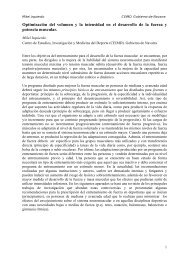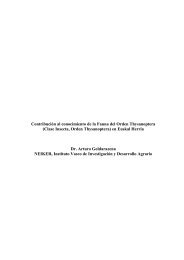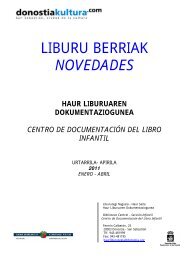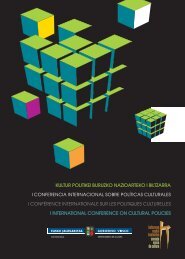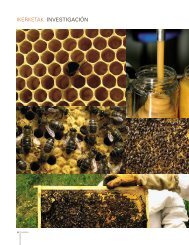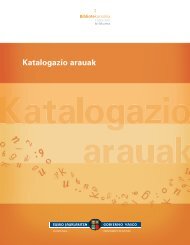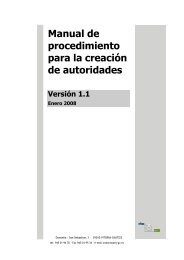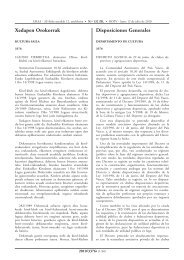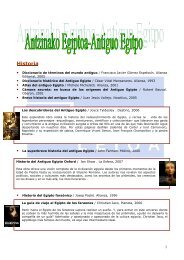The Basque Country (pdf, 4,3Mb) - Kultura Saila - Euskadi.net
The Basque Country (pdf, 4,3Mb) - Kultura Saila - Euskadi.net
The Basque Country (pdf, 4,3Mb) - Kultura Saila - Euskadi.net
Create successful ePaper yourself
Turn your PDF publications into a flip-book with our unique Google optimized e-Paper software.
58<br />
Juan Crisóstomo Arriaga.<br />
Mausoleum of Julián Gayarre.<br />
El Roncal, Navarra.<br />
<strong>The</strong> Orfeón Donostiarra at a<br />
performance of “Faust” by La Fura dels<br />
Baus at the Salzburg Festival.<br />
7.3.2. Music<br />
<strong>The</strong> <strong>Basque</strong> peopleʼs love affair with vocal and instrumental music<br />
is long-standing. It is often said that three <strong>Basque</strong>s sharing a meal<br />
make a choir. In fact choral groups have a long-standing popular<br />
tradition, and although they have experienced a certain decline in<br />
recent times, there are more than 80 choirs in Iparralde alone.<br />
<strong>The</strong>re is evidence of musical continuity during Roman times and<br />
also in the Middle Ages, as shown by the numerous cantares<br />
(poems set to music), such as Batalla de Beotibar, Cantar de<br />
Bereterretxe, Lelo il Lelo, as well as laments. In the Renaissance,<br />
the cantares continued (de Olaso, Cancionero de palacio...) and<br />
polyphonic music appeared, with Joannes Anchieta (1462-<br />
1523) as its maximum exponent. <strong>The</strong> Baroque period brought a<br />
proliferation of musical groups and master organ makers, as well<br />
as carols, folksongs, and pastoral plays.<br />
<strong>The</strong> ni<strong>net</strong>eenth century, especially the period of Romanticism,<br />
was splendid, with composers such as Bilbao-native Juan<br />
Crisóstomo Arriaga – who died very young and was called the<br />
<strong>Basque</strong> Mozart for his Sinfonía en re (Symphony in D) and Los<br />
esclavos felices – and Navarrese Hilarión Eslava (composer<br />
and pedagogue), Pablo Sarasate (violinist) and Julián Gayarre<br />
(tenor). Also from Navarre was Pascual Emilio Arrieta, who<br />
composed the opera Ildegonda, and successful zarzuelas such as<br />
Marina (later made into an opera) and El dominó azul”. <strong>The</strong>re was<br />
also upsurge in popular music (groups of txistu players, choral<br />
societies, choirs, bands, pastorals and bertsolarismo) and a great<br />
increase in all the capital cities of conservatories, symphonic<br />
orchestras, choral societies, and philharmonic societies.<br />
<strong>The</strong> twentieth century is marked by two internationally acclaimed<br />
composers: the impressionist Maurice Ravel (1875-1937), born<br />
in Ziburu, Iparralde, author of Pavana para una infanta difunta,<br />
Conciertos para piano, operas, ballets, and the famous Bolero;<br />
and Álava-born Jesús Guridi (Amaya, El Caserío or Diez melodías<br />
vascas...). But during this period there was also a genuine musical<br />
renaissance with a treasure-trove of magnificent composers including<br />
José María Usandizaga, Francisco Madina, Tomás Garbizu, Tomás<br />
Aragüés, Jesús Arambarri, Luis Aramburu, the neo-Romantic Pablo<br />
Sorozabal and the impressionist Aita Donostia.<br />
<strong>The</strong>re are not many <strong>Basque</strong> operas. <strong>The</strong> first (Pudente), with music by<br />
José Antonio Santesteban and libretto by Serafín Baroja, premiered<br />
in Donostia in 1884. In recent years some of the operas by <strong>Basque</strong><br />
composers have made a comeback, including Mendi-mediyan by<br />
Usandizaga, Amaya by Jesús Guridi and Larraldeko Lorea by Aita<br />
Donostia. Other operas that have debuted over the years include<br />
Zigor (1963) and Gernika (1986) by Francisco Escudero (Zarautz,<br />
1912-Donostia, 2002), whose body of work spans a wide range of<br />
genres, his music straddling musical renovation and avant-gardism.<br />
In contemporary classical music Carmelo Bernaola, Luis de<br />
Pablo and Antón Larrauri deserve special mention, as do more<br />
recent names such as Félix Ibarrondo, Ramón Lazkano and<br />
Gabriel Erkoreka. Composers of music for films include Alberto<br />
Iglesias – whose musical scores earned him Oscar nominations<br />
for the films <strong>The</strong> Constant Gardener and <strong>The</strong> Kite Runner – Angel<br />
IIllarramendi and Bingen Miendizabal.<br />
<strong>Basque</strong> performers giving concerts all over the world include San<br />
Sebastian harpist Nicanor Zabaleta (1907-1993), Bilbao-born<br />
pianist Joaquín Achúcarro. <strong>The</strong>re have also been innumerable<br />
excellent txistu players, including the txistulari family, the<br />
Ansorenas. <strong>The</strong> singer of operettas and reviews, Irun-born Luis<br />
Mariano (1920-70) was very popular. In lyrical song the María<br />
Bayo from Navarra, and Ainhoa Arteta should be highlighted.<br />
Traditions, institutions and memory<br />
<strong>The</strong> most representative instruments, all of which have a very long<br />
history, are the txistu (three-holed flute), the tabor, the dulzaina, the<br />
txalaparta – a percussion instrument made of two wooden planks<br />
presently enjoying a comeback – and the alboka. <strong>The</strong> trikitixa, a<br />
small diatonic accordion introduced in Euskal Herria at the end of<br />
the ni<strong>net</strong>eenth century, is also a very popular instrument.<br />
Also worth highlighting are the Navarrese traditions of the jota<br />
–a song sung in Spanish in which a short poem is created in the<br />
form of a quatrain– and the auroras, which are sung by groups to<br />
announce important festivities. Raimundo Lanas was the most<br />
famous singer of jotas and brought a spirit of renewal to the art.<br />
As for orchestras, the <strong>Basque</strong> National Orchestra (Orquesta Sinfónica<br />
de <strong>Euskadi</strong>, or OSE), the Bilbao Symphony Orchestra (Orquesta<br />
Sinfónica de Bilbao, BOS) – founded in 1922 – and the Orquesta<br />
Pablo Sarasate (Pamplona-Iruña) all have busy performance<br />
schedules. <strong>The</strong> <strong>Basque</strong> Youth Orchestra (Joven Orquesta de Euskal<br />
Herria, or EGO.), created in 1997, gives performances twice a<br />
year. Bilbao has an Accordion Symphony Orchestra conducted by<br />
Amagoia Loroño. As for choral societies, the Orfeón Donostiarra<br />
is the most well-known at the international level. Also with long<br />
traditions are the Choral Society of Bilbao, the choirs attached to<br />
the Bilbao Association of Friends of the Opera (ABAO), the Andra<br />
Mari choir (Errenteria), the Easo choir and, in Navarre, the “Orfeón<br />
Pamplonés” and the “Coral de Cámara” chamber choir.<br />
<strong>The</strong> ABAO ensures the continuity of opera programming, and Musikene,<br />
in Donostia-San Sebastian, is the tertiary-level conservatory of music.<br />
<strong>The</strong> <strong>Basque</strong> Archive of Music, Eresbil, is a public foundation devoted<br />
to preserving the <strong>Basque</strong> musical memory. It safeguards songs, texts,<br />
musical scores, etc. Located in Errenteria, Gipuzkoa, the foundation<br />
has more than 100 collections and a roster of nearly 1500 <strong>Basque</strong> and<br />
Navarrese composers. It also holds a copy of the legal deposit.




